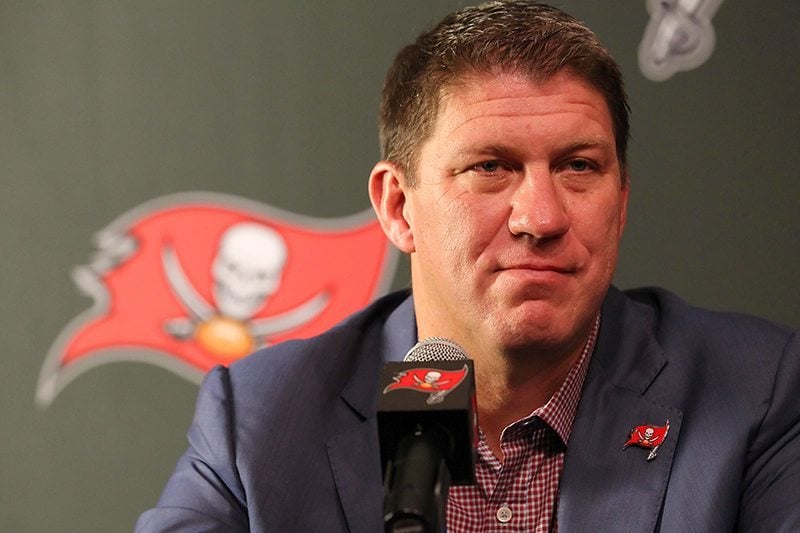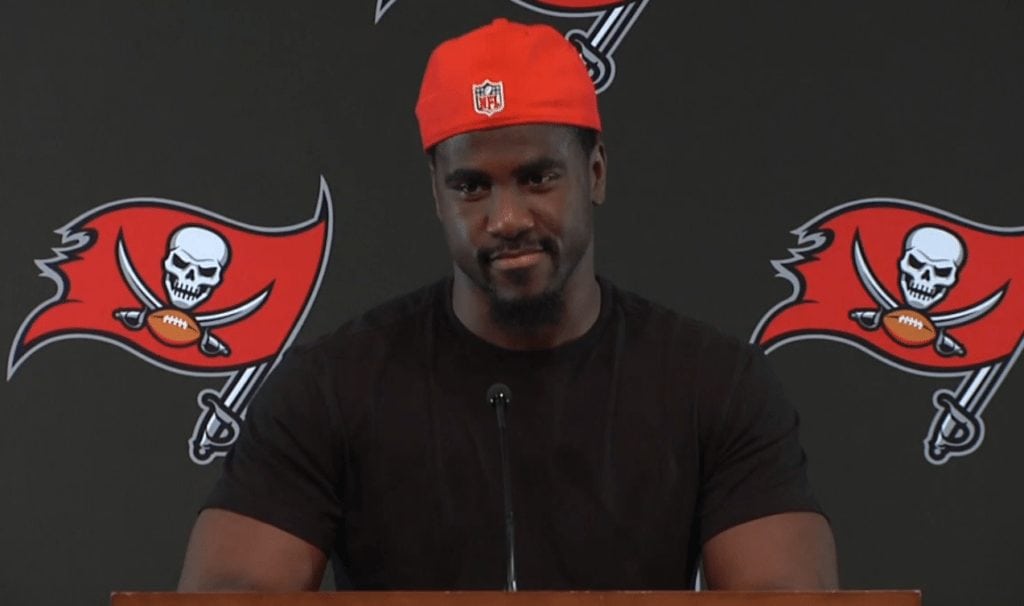SR’s Fab 5 is a collection of inside scoop, analysis and insight from yours truly, PewterReport.com publisher and Bucs beat writer Scott Reynolds. Here are a few things that caught my attention this week at One Buc Place and around the NFL.
FAB 1. INSIDE THE BUCS’ SELECTION OF O.J. HOWARD
There was no debate inside the Buccaneers’ war room when Tampa Bay came on the clock with the 19th pick in the 2017 NFL Draft.
Once it was known that Tennessee was going to draft USC cornerback Adoreé Jackson, a player that the Bucs really liked, the drafting of Alabama tight end O.J. Howard was as automatic as breathing for general manager Jason Licht. While the Bucs were prepared for the slim possibility that a player Licht had ranked near the top 5 in this draft would fall to them, they couldn’t believe it was happening.
As Howard began sliding down the first round of the draft, Bucs director of football administration Mike Greenberg sensed the Alabama star could actually be available at No. 19 because the tight ends is a position that is prone to slip in the draft, and he made that point known to Licht. When it came time to turn the card in the Bucs did so immediately.
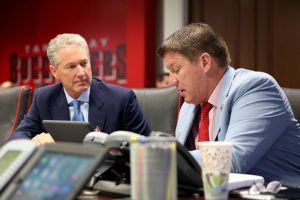
Bucs head coach Dirk Koetter and GM Jason Licht – Photo courtesy of the Buccaneers
There was no debating or deliberating Florida State running back Dalvin Cook at that point. Tampa Bay liked Cook, but there were some real concerns about some of the people from his hometown of Miami that ran in Cook’s inner circle. He wasn’t going to be the pick at No. 19.
It was clear it was going to be Howard.
Licht, head coach Dirk Koetter, director of college scouting Mike Biehl and everyone in Tampa Bay’s war room was in unison that Howard was going to be a Buccaneer.
“It was a very relaxed room,” Licht told me in post-draft interview with PewterReport.com. “We had gone over so many different scenarios. I, at one point, told one of our owners during the National Championship Game, ‘I hope this tight end is staring us in the face.’ Then we were at the Senior Bowl and there were a couple of plays O.J. made where Dirk looked at me and said, ‘Wow!’ Then we went to the Owners Meetings and Dirk and I were talking about O.J. and two other players that were very high on our board – I don’t want to say who they were, but very high on our board – and maybe at a need position for us. I said, ‘If O.J. is sitting there are you comfortable taking him over these other two? I’ll tell you my answer at the same time and we’ll go 1-2-3.’ We both said yes.
“We went through that scenario. It was surprising he came to us, but it wasn’t something that was out of the blue. We had talked about it enough that when I found out who Tennessee was taking before it was announced it was like, ‘Hell yeah!’ It was the calm before the storm. I was sweating my ass off, but I was still calm!”
Many in the media have said that the Bucs got the steal of the draft in selecting Howard, who was widely regarded as a top 10 pick, with the 19th overall pick. While some Tampa Bay fans were struggling to see tight end as a need position with the emergence of Cameron Brate, who scored eight touchdowns last year, which was tied for the most in the league by a tight end, it was a huge need in the eyes of the Bucs front office and coaches.
Brate is an ideal “F” tight end, which is a “move” tight end whose primary role is to be a pass-catcher rather than a blocker. A “Y” tight end is an in-line blocking tight end, who is featured at the point of attack. Brate is a decent blocker who gives maximum effort, but blocking isn’t his biggest strength.
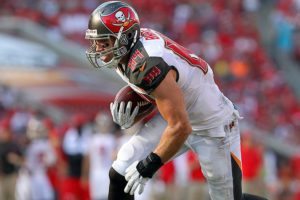
Bucs TE Cam Brate – Photo by: Cliff Welch/PR
“Cam has great ball skills and can contort his body and make contested catches,” Licht said. “That’s what makes him so special.”
In Howard, the Bucs got a big, 6-foot-6, 251-pound “Y” tight end that can block, as he did often at Alabama for the likes of T.J. Yeldon, Derrick Henry, Kenyon Drake and Bo Scarborough. But Howard has 4.51 speed and was an underused pass-catching weapon for the Crimson Tide. The Bucs plan on featuring Howard in a passing game that also includes Mike Evans, DeSean Jackson, Adam Humphries and Brate.
The Bucs plan on using a lot of double tight end sets – otherwise known as 12 personnel (one back, two tight ends, two receivers) – in 2017 with Howard’s arrival, and that was actually the plan last year until Austin Seferian-Jenkins, Brate’s backup and a good receiving tight end, was cut prior to Week 3 for a DUI among other character concerns. Remember that Tampa Bay began the 2016 campaign with five tight ends on the roster in Brate, Seferian-Jenkins, Luke Stocker, Brandon Myers and Alan Cross. Stocker was also used at fullback, and Cross, an undrafted free agent in 2016, was primarily used as a fullback and on special teams.
“Without a doubt I’m excited,” new Bucs tight ends coach Ben Steele said. “Obviously being a first-year tight ends coach here and adding two very good tight ends in our first-round pick, O.J. Howard, and Antony Auclair has me excited. Our guys understand that we are not a single tight end offense. We are a two-tight end offense.”
With the Bucs opting to not re-sign Myers, who will be 32 in September, the team only had two proven tight ends on the roster in Stocker, who is a good blocker, but isn’t much of a receiving threat, and Brate. Tampa Bay was going to add a tight end in this year’s draft – maybe two – but Howard was the only one with a first-round grade.
Howard has the chance to be very special, and Licht has studied the impact that tight ends have on the quarterback positions. The conclusion? Most great quarterbacks had great tight ends.
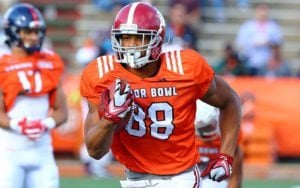
Alabama TE OJ Howard – Photo by: Courtland Richards
“A tight end is the quarterback’s best friend,” Licht said.
That was true for Winston at Florida State where Nick O’Leary compiled over 1,000 receiving yards and 13 touchdowns in two years playing with the 2013 Heisman Trophy winner, and also last year where Brate was Tampa Bay’s second-leading receiver with 57 catches for 660 yards and eight touchdowns. History shows that Licht is right when it comes to having a great tight end aid a quarterback in becoming great.
Dave Casper, one of the few tight ends in the Pro Football Hall of Fame, was a five-time Pro Bowler in Oakland where he played from 1974-80. Casper quickly became quarterback Kenny Stabler’s favorite target and helped Oakland win Super Bowl XI in 1976.
Although he never played in a Super Bowl in San Diego, Hall of Fame quarterback Dan Fouts was greatly aided by five-time Pro Bowl tight end Kellen Winslow, who is one of only eight tight ends in the Pro Football Hall of Fame. One of the best quarterbacks of all time, Joe Montana, won four Super Bowls in San Francisco – two with two-time Pro Bowler Dwight Clark and two with four-time Pro Bowler Brent Jones.
Denver quarterback John Elway was unsuccessful in winning three Super Bowls until the Broncos drafted Shannon Sharpe in 1990 coming off a defeat in Super Bowl XXIV in 1989. With Sharpe, who became an eight-time Pro Bowler, Elway finally won two Super Bowls back-to-back in 1997-98 and helped Sharpe amass over 10,000 receiving yards and 62 touchdowns in his Hall of Fame career.
While Dallas quarterback Troy Aikman had a Hall of Fame receiver to throw to in Michael Irvin, he also had Jay Novacek, a five-time Pro Bowl tight end as his security blanket. Novacek was instrumental in helping the Cowboys win three Super Bowls in the 1990s. Green Bay Hall of Fame quarterback Brett Favre won his only Super Bowl in 1996 with three-time Pro Bowl tight end Mark Chmura to throw to down the seam.
Hall of Fame quarterback Peyton Manning only won one Super Bowl in Indianapolis and that came with Dallas Clark as his receiving tight end. Although Clark only made one Pro Bowl in 2009, he totaled 427 catches for 4,887 yards and 46 touchdowns in his nine years with the Colts. That’s actually better production than what Novacek had in Dallas with 422 catches for 4,630 yards and 30 TDs during his illustrious career.
Drew Brees didn’t win a Super Bowl in New Orleans in 2009 until the Saints acquired Pro Bowl tight end Jeremy Shockey a year earlier. Shockey had previously helped New York Giants quarterback Eli Manning beat New England in Super Bowl XLII. Shockey’s last season in New Orleans came in 2010 when the Saints drafted his replacement in Jimmy Graham, who became a four-time Pro Bowl tight end and helped Brees become an eventual Hall of Famer by catching 386 passes for 4,752 yards and 51 touchdowns from 2010-14.
In February, New England’s future Hall of Famer, Tom Brady, became the best quarterback in NFL history when he won his fifth Super Bowl. Head coach Bill Belichick stockpiled the tight end position with Martellus Bennett even though the Patriots had four-time Pro Bowler Rob Gronkowski on the roster. Gronkowski didn’t play in the Super Bowl due to injury, but helped Brady win Super Bowl XLIX over Seattle with a touchdown catch in that game. Bennett, who was New England’s second-leading receiver last season, had five catches for 62 yards in the Super Bowl LI victory.
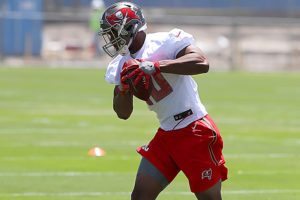
Bucs TE O.J. Howard – Photo by: Cliff Welch/PR
With Howard the Bucs believe they have a player that can be a dominant tight end with rare speed and size that can help Winston get to a whole new level.
The drafting of Howard also had to do with Licht’s mantra to add more speed to the offense this offseason. During the season when watching receivers struggle to separate and watching Winston have to hold on to the ball he wrote the word “SPEED” on his white board in the office as a constant reminder to find faster players in free agency and the draft.
“Horizontal passes, the seam passes the outlet pass – it had a lot to do with the lack of speed we had at the position [outside of Brate],” Licht said. “But with our lack of speed on offense – we’ve picked it up with DeSean Jackson and O.J. – and I felt that’s why Jameis took a lot of hits. Mike Evans was getting doubled and things were slow to develop. It has an effect on your protection and makes your offensive line look bad.”
Drafting Howard not only helps Tampa Bay’s run game because he’s a dominant in-line blocking “Y” tight end, but also the passing game from giving Winston another weapon to helping the offensive line because of his speed and his ability to quickly separate and present himself as a viable target.
“The great quarterbacks have a revolving door of running backs in their careers,” Licht said. “Troy Aikman did have Emmitt Smith, but it’s usually a revolving door. Most of the great quarterbacks had a really good tight end, though.”
Next I’ll take you inside Licht’s Bucs draft board.

